 Editor’s Note: One in six men in the United States will have prostate cancer, and more than 65% of all prostate cancers are diagnosed in men over the age of 65. Through his 5-month odyssey, outdoors sports writer John Phillips learned that prostate cancer doesn’t have to be a death sentence, and the treatment for it doesn’t have to hurt or have severe side effects.
Editor’s Note: One in six men in the United States will have prostate cancer, and more than 65% of all prostate cancers are diagnosed in men over the age of 65. Through his 5-month odyssey, outdoors sports writer John Phillips learned that prostate cancer doesn’t have to be a death sentence, and the treatment for it doesn’t have to hurt or have severe side effects.
If your prostate cancer is discovered early, treatment doesn’t have to be a major discomfort or interfere with your life. However, all prostate cancer isn’t the same, and the same treatment isn’t recommended for everyone. The more you know about the diagnosis and the treatment of prostate cancer not only can save your life but also offset many of the fears and the concerns you’ll have after your initial diagnosis. This article is not intended to serve as medical advice – always consult your physician.
We sincerely hope that what you learn from John’s experience may help you, your friends and/or your family members.
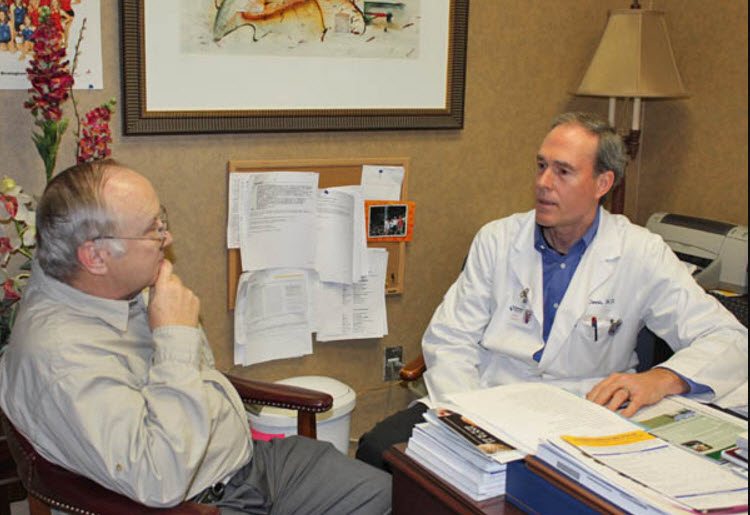
John wasn’t ready to learn the news his doctor had for him about prostate cancer.
Prostate Cancer? Not Me.
“I’m sorry, Mr. Phillips,” Dr. Rodney Dennis of the Urology Centers of Alabama in Birmingham, Alabama, told me. “The biopsy indicates that you have prostate cancer. But it’s only a 6 on a scale of 1 to 10 on the Gleason Scale. You have several options. We can remove the prostate, or you can choose to have one of several forms of radiation. The good news is you’ve got time to consider some different types of cancer treatments and choose the one you believe is best for you. I believe your cancer is very treatable.”
Because of my frequency of getting up several times a night to go to the bathroom, my daughter, who is a nurse, and my son-in-law, who is a doctor, had suggested I see my urologist.
Dr. Rodney Dennis had also helped me weather several kidney stone attacks. Dr. Dennis had been treating my frequency problem for a couple of years with medicine. He’d done a yearly PSA test, a blood test used to detect prostate cancer, especially in the early stages. After the first PSA, Dr. Dennis asked me to wait a month before returning for a second test.
Since the second PSA yielded the same results as the first test, Dr. Dennis suggested he do a biopsy. I talked to several friends, who felt the biopsy was a total pain. One friend observed that each time his doctor had taken a sample of his prostate, he’d felt as though someone was putting a hot poker inside of him. I was a little concerned but ready to bite the bullet and take the pain.
Before the procedure started, I explained to Dr. Dennis my philosophy that the definition of modern medicine was the relief of suffering, not inflicting suffering. He assured me that everything would be okay, and he was right. There was no pain involved in the biopsy. I was really rather ashamed for being so fearful.
But after the biopsy, I got good and bad news. I had prostate cancer, and my Gleason score was 6. (Go to www.psa-rising.com/prostatecancer/biopsy.htm to learn more about what this means).
I kept thinking to myself: “Besides deer hunting, I’ve got the SHOT (Shooting, Hunting and Outdoor Trade) Show, the ATA (Archery Trade Association) Show and the Bassmaster Classic all coming up during January and February. Then turkey season starts. I’ve got stories to write, pictures to take, places to go and people to see. I don’t have time to have cancer.”

John stays busy out in the field taking action shots for hunting and fishing magazines. He didn’t have time for prostate cancer.
I told the doctor about all my commitments and asked if I could postpone treatment until after the Bassmaster Classic in mid-February. “The sooner you get treatment, the better off you’ll be,” Dr. Dennis said. “But I think you’re okay to wait 4 to 6 weeks if necessary.”
I talked further with Dr. Dennis about my treatment options. Now, I know from my son-in-law, who is an emergency-room physician, and from my daughter, who is a nurse, that doctors don’t like to tell patients which options they should choose. But I also wanted to get the best advice I could get.
So, I asked Dr. Dennis if he thought my outcome would be as good with radiation as it would be with surgery. Dr. Dennis said he thought I would do fine with the radiation. He’d found the cancer early and thought we should be able to successfully treat it. He also explained that there were several ways to deliver that radiation and informed me of some of my options.
“The good news is that because you took the PSA test, we were able to find the cancer at its early stages and should be able to treat it before it becomes a major concern,” Dr. Dennis advised. “Men need to have PSA tests, because early diagnosis is one way we can treat and kill prostate cancer before it becomes a problem.”
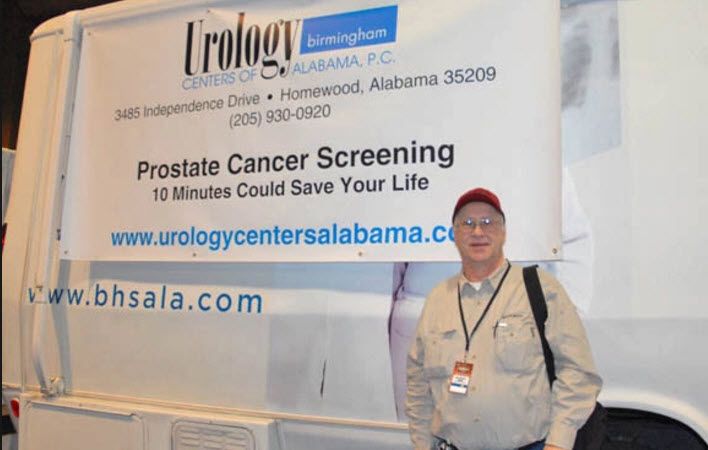
Get checked for prostate cancer like John Phillips did! It might save your life.
One of the best advantages of having a son-in-law, who’s a doctor, and a daughter, who’s a nurse, is that they’re very proficient at researching. So, as soon as I told them I had prostate cancer, they lit up the Internet, doing all the research they could on prostate cancer and treatment. But I had one more source I hadn’t told anyone about, except my wife, and that was my longtime friend, Barry Smith.
John Talked to Someone Who Had Prostate Cancer to Get His Take on the Disease
Last summer I found out that a longtime, close friend of mine, Barry Smith, had prostate cancer. I was very worried and concerned about Barry, because you didn’t often find friends who will help you like Barry.
I first met Barry when he worked for Alabama’s Department of Conservation and Natural Resources as a fisheries biologist and then later headed-up that department at the State of Alabama. Over the years, I’d interviewed Barry for hundreds of articles on fish and fishing. Barry and another friend of mine, Don Keller, formed their own fish hatchery and research center, American Sportfish.
Through the research and experimentation that Barry and Don had done, they bred two new strains of largemouth bass. They called the super-aggressive northern strain the Tiger Bass, and the hybrid, a cross between the Tiger Bass and the Florida strain of black bass, the Gorilla Bass. The extremely-aggressive and fast-growing Gorilla Bass at 3- to 5-years old would weigh anywhere from 6- to 10-pounds each and continue to exhibit that aggressive feeding behavior, making these bass easy to catch on artificial lures. Barry had demonstrated to me his ability to research successfully.
When I found out that Barry had prostate cancer, I was really concerned, but glad to know that Barry was also coming to Birmingham where I live, for treatments.
And, often after his treatments, he’d come by our house to visit. He told me about the radiation treatment he’d had called TomoTherapy, a revolutionary new type of radiation, that combined CT imaging and delivered radiation treatments with speed and precision, increased accuracy and decreased side effects.

John and his brother, famous outdoorsman Archie Phillips, both believe in researching the best options for medical care.
To my amazement, Barry never was mentally or physically down. “John, I can’t believe how well my radiation has gone. I haven’t gotten sick, I haven’t had any problems, and the only effect I can tell from TomoTherapy is that instead of being able to play three sets of tennis a day, I only could play two sets toward the last couple of weeks of my treatment.”
So of course, when I learned I had prostate cancer, I called Barry to find out what he thought about the type of radiation he’d had and ask him for suggestions about what he thought I could do. I knew Barry already had been through what I was facing and had come out a winner.
Barry told me, “The first thing I recommend, John, is that you don’t panic. You’ve got time to do your research and figure-out what type of treatment is best for you. From the time I was diagnosed, I spent 6 months researching the different types of treatment available for prostate cancer on the internet, and I talked to many different people who had had prostate cancer.
“Some of them had incontinence problems and diarrhea and were really sick after their treatments. Others had had little or no problems from their treatments. Either way, we can handle the issues that come with treatment,” he said.
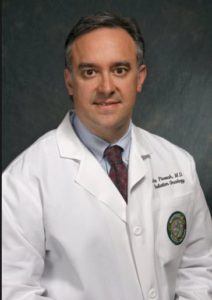
Dr. John Fiveash of the Kirklin Clinic, a part of the University of Alabama at Birmingham’s (UAB) Comprehensive Cancer Center.
From the internet and the people I talked with, I found out about TomoTherapy. At the time, I was considering my treatment there were only three TomoTherapy machines in Alabama, and two of them were in Birmingham. So, I started researching who was the best doctor to deliver this type of treatment in Alabama and learned about Dr. John Fiveash of the Kirklin Clinic, a part of the University of Alabama at Birmingham’s (UAB) Comprehensive Cancer Center, one of about 2-dozen comprehensive cancer centers in the country.
Not only does Dr. Fiveash deliver this type of treatment, he has one of the longest records of follow-up care with the patients he’s treated. He also teaches other doctors how to do this TomoTherapy treatment. I really suggest you talk with him before you make a decision.”
John Says the Best Advice about Cancer Isn’t Always the Best Advice
From 5-year-old kindergarten through two degrees in college, I’ve had my daughter in the best private schools I could find. She has a college degree in nursing and a degree in journalism, and I’m convinced that she knows most everything there is to know in the known world.
My son-in-law is one of the best trauma doctors I’ve ever met. He handles everything from shootings and stabbings to heart attacks and near-death experiences in the emergency room.
If I’m sick or hurt, these two are who I go to for advice.
I have a huge medical resource at my fingertips. Both of them understand how to study and research anything they don’t know. Once they found out I had prostate cancer, they cranked-up the computer and begin to look for and learn about the best treatment they could find for me.
When I mentioned Barry Smith, they gave me the usual, “Yeah, Dad, he’s a good friend, and I know he wants to help, but he’s not a medical person. We need to research the effects of all forms of prostate-cancer treatment and the long-term results. Then we can help you decide on what’s best for you. We really think you should consider the standard 48 days worth of radiation that’s been tried and tested for many years. But we will research TomoTherapy and Dr. Fiveash as well.”

John met with Dr. Fiveash to research his options for treating prostate cancer.
First of all, you can ask almost any child, and he or she will tell you they know more than their Daddy does. However, what Kate and Joe didn’t realize was that Barry Smith was a research scientist, although his research was primarily with fish. But Barry knew how to research and find out what he didn’t know.
I called Barry again, told him what my daughter and son-in-law had suggested, and Barry said, “John, I’ve never really asked you for anything as long as I’ve known you, have I?” I thought for a moment and said, “No, Barry you never have.”
And Barry said, “John, I’m asking you now as a friend to make an appointment, get a second opinion. I know your daughter and your son-in-law want what’s best for you, but since they’re both medical people, they should understand that you can’t lose by getting a second opinion. If for no other reason than our friendship, I’m asking you to do this for me.”
I assured Barry that I would meet with Dr. Fiveash for a second opinion, and that I would discuss TomoTherapy with him. When I told my daughter I was going for a second opinion, she agreed that it was a good idea and added, “I’m going with you, Daddy. I know more about medicine than you do, and there are some questions I want to ask Dr. Fiveash.”
I’m thankful that I have a daughter, a son-in-law and a son who not only care about my health but intend to be involved and help me make right decisions.
So, we went to the Kirklin Clinic at the University of Alabama at Birmingham’s (UAB) Comprehensive Cancer Center, known nationally as one of the top cancer centers anywhere and on the cutting edge of searching for cures for all types of cancer. Before my daughter and I went to UAB, she did her research on Dr. Fiveash and probably knew as much about him as his mother did. She researched TomoTherapy and agreed that we needed to consider it after she had gone with me to talk with Dr. Fiveash.
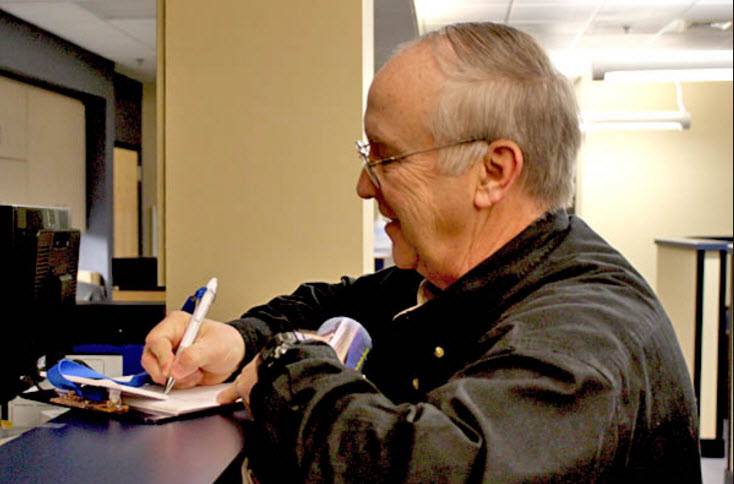
John Learns How TomoTherapy Works
“We’ve got 5-years worth of follow-up data on the patients we’ve treated with TomoTherapy, and we’ve learned it’s an effective way to treat prostate cancer, usually with far-fewer side effects than other forms of radiation,” Dr. John Fiveash explained to my daughter and me. “Before each treatment, patients are given a CT scan, so that the radiation therapist can see the position of the prostate, which can move, see the areas that need to be radiated and line-up the machine, so that it radiates the prostate. Radiation is sent from several different directions and targeted specifically on the prostate. This way you have fewer side effects because you’re radiating smaller areas more precisely.
Most of our patients can continue their daily work. I recommend you have 28 treatments, one treatment a day, 5 days a week. And, I expect you’ll be able to continue on with your daily work.”

Like most guys, John would rather be fishing than fighting prostate cancer.
When I explained my schedule to Dr. Fiveash, and we saw that there was a 3-week gap between the SHOT Show and the Bassmaster Classic taking place, and then I didn’t have too many commitments after the first of March, since most of my planned turkey hunting would take place toward the end of March – the end of April, my daughter said, “Dad could start the Monday after the SHOT Show ends. If he could get his treatments in the mornings, he still could work the Bassmaster Classic the third week in February. He’d be finished with his treatments before his planned turkey hunts.” Dr. Fiveash grinned and said, “That’ll work.”
After 1-1/2-hours of intensive questioning by my daughter, I’m sure Dr. Fiveash thought he’d experienced an interrogation much like a suspect who’d been caught by the police outside a bank with a bag of money.
However, when we left his office, my daughter observed, “Dr. Fiveash knows his stuff, Dad. He’s on the cutting edge of cancer research and treatment. I can’t believe we’ve found someone like him here in Birmingham. I definitely think you ought to do TomoTherapy with him. This type of treatment should let you do everything you want to do. It shouldn’t make you sick, you shouldn’t hurt, and it should kill the cancer cells in your prostate. And, Dr. Fiveash has the research to prove it.” After my daughter talked to her husband (the doctor), and my son and my wife talked with her and her husband, my family agreed that this is the treatment I should use for my prostate cancer.
My next big concern was, “What are they going to do to me?”

John’s fear of cancer treatment began when his wife Denise [right] fought breast cancer 25 years ago.
What Having TomoTherapy Was Like for John
My wife had breast cancer more than 25 years ago and was radiated for her cancer. She was burned and terribly weak, but she came out of the process cancer-free and glad she could be treated, as we all were. I had known other people who’d had radiation and had side affects that I wasn’t looking forward to experiencing.
So, I was somewhat apprehensive, even though Dr. John Fiveash, my family and my close friend Barry Smith (who had had TomoTherapy for his cancer the year before) said that I probably wouldn’t have an side effects other than fatigue at the end of my treatment.
When I went to the Kirklin Clinic for the first time, I really didn’t know what to expect.
The radiation therapist asked me to, “Strip from your waist down, and put on a hospital gown.” Then I was led into a room where a cast was made of both of my legs from the knees down. I explained that I didn’t have a broken leg, but that I had prostate cancer.

The kind therapist explained that this cast would be used to make sure that I was straight in the TomoTherapy machine, and that my body was lined-up perfectly every time I was given radiation. The therapist also said, “Now we need to put three small dots on the lower part of your stomach. We’ll use these dots to help line-up the rest of your body to make sure we get you straight in the machine. We can do this with an indelible marker, but it may wash off. Most people opt for three small tattoos that will be permanent and won’t wash off.”
When I asked him, “What’s the best and the easiest?” he replied, “The tattoos, which will be so small that you and no one else will notice them.”
I answered, “Okay, but I don’t want a tattoo of a naked lady, a bulldog or a sailing ship.”
He laughed and said, “No, Mr. Phillips. We’re not going to do those types of tattoos. The tattoo you’re getting is only going to be three little dots.” We both laughed, and I got the tattoos.
When I started radiation, each day I’d sign-in, walk to the men’s dressing room, put on my hospital gown and usually go straight to the TomoTherapy machine. Someone asked me what the TomoTherapy machine looked like, and I compared it to a can of spinach.
“The therapist rolls me into this cylinder on a table, I get my treatment, and I come out feeling like Popeye.” I was put inside a large cylinder (the TomoTherapy machine) where I got a CT scan first of all. The radiation therapist, after looking at my prostate on the scan, would return to the room and then using the CT scan as a guide line-up the machine and me for my treatment.
The actual treatment seemed to take less than 2 minutes. From the time I walked in the door until I left usually took a maximum of 45 minutes. Now that I’ve completed my TomoTherapy radiation, I almost feel kind of guilty because I haven’t had any discomfort, but I am so thankful.
The worst day I had at radiation therapy was one morning after I’d put on my hospital gown and started out of the dressing room toward the Tomo machine. But I was stopped and couldn’t move. I didn’t know what the problem was. I’d never experienced anything like this, since I’d been going to the Kirklin Clinic. However, for some reason, I couldn’t move forward.
When I finally looked over my shoulder, I saw that I’d slammed the door of my locker on the tail of my hospital gown, and the gown was stuck in the door.

But after I opened the door and got my gown out of the locker, everything else went fine at therapy. Seriously, the only side effect I experienced was a slight burning (not bad – just noticeable) when I urinated.
The therapist suggested that if I didn’t like to drink cranberry juice that I take cranberry pills – something we didn’t know even existed. Once I started taking the cranberry pills, within only a couple of days, that slight irritation went away.
The other side effect occurred when during the last 2 weeks of my treatment I didn’t feel like going out and walking a 5K like I normally did several times a week.
However, my longtime friend Barry Smith, who had had the TomoTherapy, last year, assured me that, “For about 2 weeks after therapy, I didn’t feel like exercising. But then I went right back to my exercise program and haven’t had any ill effects since my therapy. My PSA test dropped dramatically, and I haven’t had any problems with waking up at night to go to the bathroom.”
Back during the summer months, our son decided that his mother and I needed to lose weight, build-up our stamina and get healthier, after our extended family experienced several cancer scares. As a PE teacher and a coach who has studied extensively what’s required to be healthy, he volunteered to become our personal trainer and signed us up to do a 5K walk during February, while he participated in a marathon.
When we realized that the walk would occur right in the middle of my TomoTherapy treatment, our son, who had paid his own money for our entry fees to cheer us on, said, “Dad, you don’t have to worry about doing the 5K walk. I know you’re having radiation and probably won’t feel like doing it.”
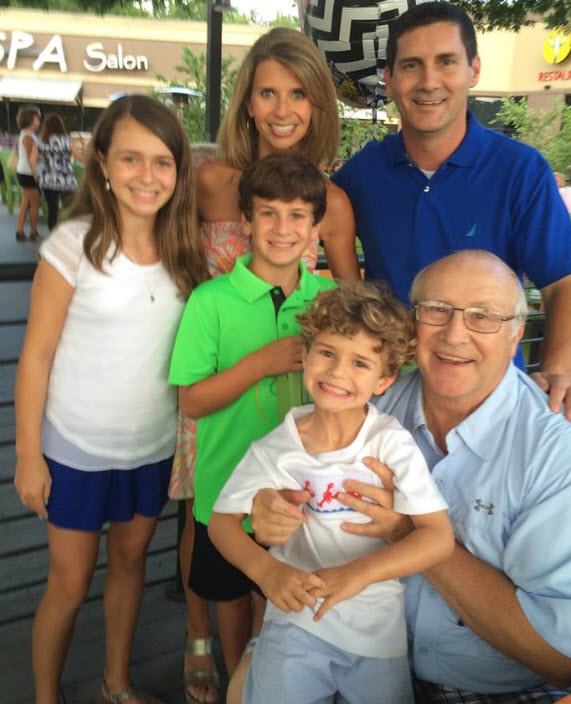
John wasn’t going to let prostate cancer stop him from seeing his grandchildren or doing 5ks with his son, John Jr.
I looked him square in the eyes and explained, “Son, since you paid $50 of your own hard-earned money to sign me up, I’m going to be in that 5K, even if I have to crawl.”
But surprisingly enough, I didn’t have any problem with completing the 5K walk, and I’ve got the T-shirt to prove it!
Of course, I realize that TomoTherapy may not be for everyone. And, I know that everyone’s cancer is not the same. However, I haven’t missed a day of work or a day of hunting and fishing because of my prostate cancer.
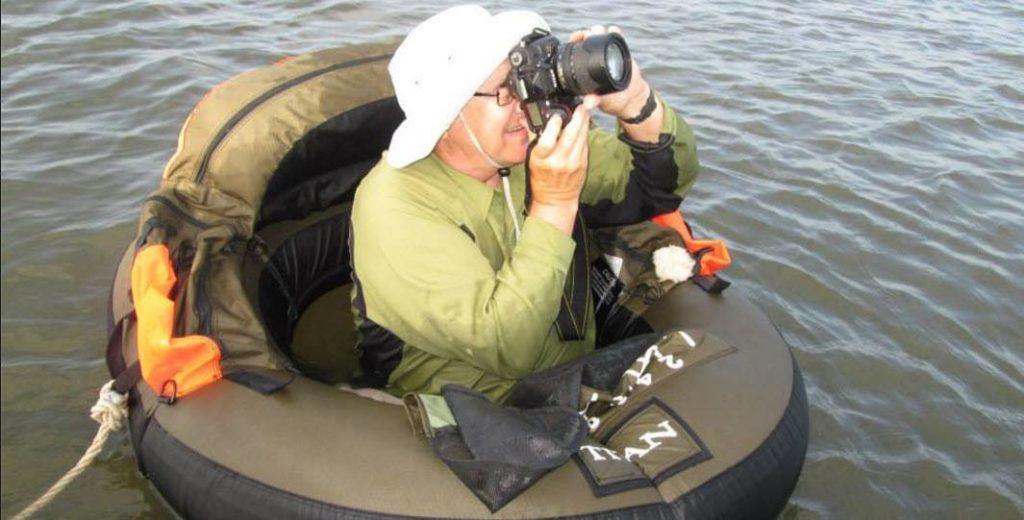
After successful treatment, John told prostate cancer to go jump in a lake.
Now that it’s completed, I want to urge you if you have prostate cancer or other forms of cancer to consider TomoTherapy. But don’t take my word for it or Barry Smith’s.
Do your own research as my family, friends and I did, and learn whether TomoTherapy may be for you. While I was at the TomoTherapy clinic, I met patients there being treated for many types of cancer, including brain cancer, back cancer, throat cancer and others I know nothing about. The ones I talked to believed as I did – that TomoTherapy was the most-painless and most-effective type of radiation treatment we could get.

John Phillips doesn’t mind sharing his story about prostate cancer if it will help you too!
 How to Learn More
How to Learn More
For more information on Dr. John Fiveash, go to www.uabradonc.com; to learn more about UAB’s Comprehensive Cancer Center, visit www3.ccc.uab.edu; for more information on TomoTherapy, check-out www.tomotheraphy.com; to learn more about John’s urologist, Dr. Rodney Dennis, visit www.urologycentersalabama.com.
Enjoy Our Free Resources & Articles
 CURE NATION is designed with you in mind, to offer assistance and education when you need it through a personal support program.
CURE NATION is designed with you in mind, to offer assistance and education when you need it through a personal support program.
All of the information you find below and on our related social media pages is meant to guide you to places, topics and, resources that enhance your life, while also connecting you with a growing group of friends.
- Sign up for our free, CURE NATION e-newsletter to have our latest stories delivered directly to you, once a month.
- Get our FREE LIFESTYLE + TRAVEL BOOKS here.
- Have an idea you’d like to share? Let us know.
- Be sure to take a minute to meet our Cure Advocates too.
You may also enjoy:

